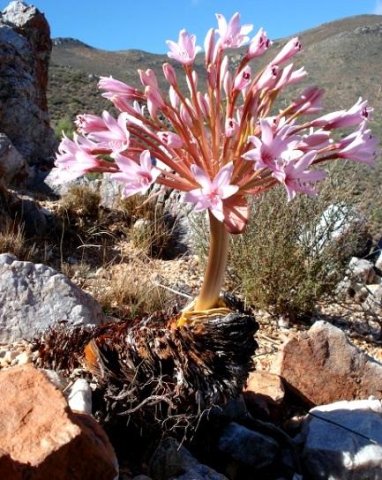Brunsvigia herrei showing much bulb

Author: Ivan Lätti
Photographer: Judd Kirkel Welwitch
This Brunsvigia herrei plant has an unusually large part of its bulb protruding from a seemingly uncomfortable perch among the rocks. Note how the papery covering tissue buries the live part of the bulb deeply and safely from the elements of the harsh climate. Normally only partly underground in this species, the bulb that typically becomes 10 cm in diameter, is smaller than those of some other Brunsvigia species. From it grows a sturdy flower stalk that presents a large umbel of pink or pale lilac flowers. The inflorescence stands about 45 cm tall.
The stored resources of the bulb are used for flowering after a little rain. There is rarely much rain in these parts though. The leaves are very broad, tongue-shaped and leathery. The leaves have red colouring on the margins, a feature that is lacking in the related B. bosmaniae. They are borne in semi-erect positions, not prostrate as B. bosmaniae does. The leaves emerge to one side of the flower stalk.
After flowering, the pedicels of the flowers grow still longer, while the fruits ripen and prepare to travel. Once the fruits are dried out, the stalk of the umbel loosens from its base and goes on a wind-propelled journey across the land as tumbleweeds do. Seeds are distributed in dribs and drabs along the way from the many storage units, the seed capsules, positioned along the outside of the ball-like structure, turned vehicle. The jolting motion of the rolling dry umbel, rolling and sometimes flying ensures dispersal of the seed, gradually and randomly. Thus chances are created for a percentage of seeds to find favourable spots for germination (Williams, 2010; www.plantzafrica.com).

